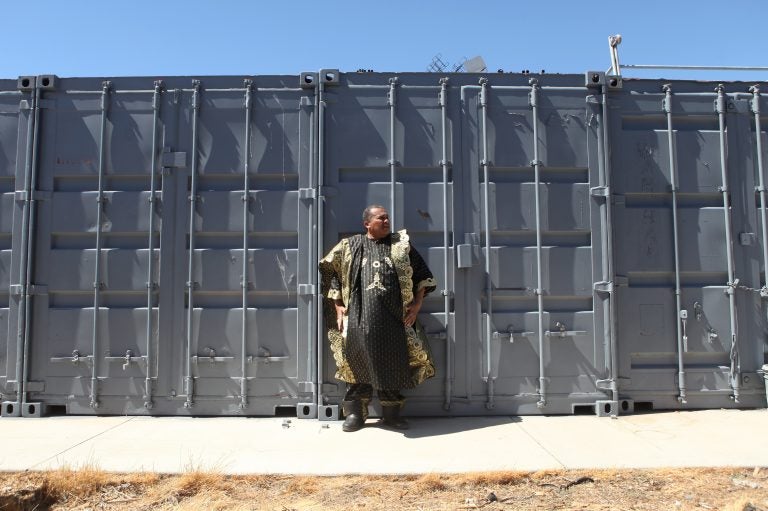Through a looking glass of black Americana: the long, strange journey of Oran Z

Oran Z. Belgrave, founder of the now defunct Oran Z's Black Facts & Wax Museum in Los Angeles, stands in front of the shipping containers that have held most of the contents of his independent African-American history museum since it closed in 2011. (Samir S. Patel/Atlas Obscura)
Summertime is for road trips. Atlas Obscura teamed up with All Things Considered to travel up the West Coast, from California to Washington, in search of “hidden wonders” — unique but overlooked people and places.
—
In the western tip of the Mojave Desert, a couple of hours north of Los Angeles, a lone McMansion-style villa sits on 10 acres surrounded by a fence. There’s little but dust, solar farms and transmission towers for miles around.
On a recent afternoon, from the villa’s oversize front door emerges a short, heavyset black man wearing an elaborate black-and-gold agbada, a sleeved robe from West Africa. His name is Oran Z.
Before he moved to this isolated spot in 2012, he presided over an independent museum of his own making, Oran Z’s Pan-African Black Facts & Wax Museum in Los Angeles. It offered a dizzying kaleidoscope of black Americana, from wax figures to historical artifacts to racist, Jim Crow-era memorabilia.
“We got to preserve the whole story,” he says. “You’ve got to deal with it and if you can’t see it, it don’t exist.”
From 1999 to 2011, the popular local attraction presented an up close and idiosyncratic view of African-American history in a largely black neighborhood.
But when a massive redevelopment project came to the area, Oran says, he was forced to close. He packed his collection — some 3 million objects, he says — into shipping containers and exiled himself to the desert.
Now, the passion project that he saw as a public service has become a millstone.
Oran, 67, is struggling with both poor health and worry over the future of his life’s work — a strange, surprising chronicle of black Americana. There’s no one — or institution — lined up to take care of the sprawling collection, and he fears this slice of an often undocumented part of African-American history may die with him.
Parts of this history are currently housed on the full-to-bursting shelves that line most of the walls in the living room of Oran and his wife of 18 years, Betty Belgrave.
Among them are some items of historical interest: baseballs from the Negro Leagues, slave shackles, a purple triangle badge used to mark Jehovah’s Witnesses in Nazi concentration camps.
And there are many blatantly racist items — from “Alligator Bait” postcards featuring black children and mammy-shape cookie jars to cast-iron “Jolly N*****” coin banks.
Derogatory depictions of African-Americans have always fascinated Oran. They are overlooked pieces of black history, he says, not often presented in museums. Part of his mission, he says, is to preserve them and ensure they are seen, as a way of understanding how black people have been dehumanized, objectified and belittled throughout history.
Oran Z’s story begins in Omaha, Neb., where he was born John Walter McLain III in 1951. At age 5, he became Oran Douglas Belgrave when his mother remarried; and later he adopted the name Oran Z (inspired by Malcolm X).
He was raised a Jehovah’s Witness and became a drummer and artist. As a young man in the early 1970s, he found inspiration in Madam C.J. Walker, an entrepreneur and activist who made her fortune with African-American hair care products in the early 20th century. If she had been able to prosper and make her mark on the world serving the black community, he figured, he could, too. So he went to beauty school.
After Oran married and had a daughter, he began buying and selling antiques and collectibles to make extra money. He had a collecting bug from a young age, and it grew into an interest in black history, especially the stories of lesser-known innovators and inventors like Walker.
During this period, he encountered a buyer, a black woman and history teacher, who was particularly interested in racist memorabilia, items that he found confusing and entrancing.
“Sometimes I would look at stuff and it would make me laugh and sometimes it would make me cry,” he recalls.
Oran opened a salon in Omaha, then an antique store and gallery, which came to focus exclusively on African-American items. He called it the Black Americana Museum.
“I started collecting anything and everything for blacks, against blacks, about blacks, by blacks,” he says. “If an African-American was represented, or if an African was represented, I wanted it.”
Oran’s collecting really took off in the early 1980s, when he developed a line of hair-weave adhesives called Oran’s Wonder Weave.
He traveled the country for hair trade shows, and, with this new income, bought everything he could find, from antique stores, yard sales and other collectors. He declines to say how much he spent over the years.
“I just thought that I was going to last for about six months, so when I got my money I would buy black memorabilia,” he says. “I have spent my last dime on things more than once.”
Then came a painful and unexpected divorce. Seeking a fresh start, Oran decamped to Los Angeles in the mid-1990s, leaving behind his business and most of his collection at the time.
Oran lived in a rented office in Santa Barbara Plaza — a strip mall full of black-owned businesses in the Baldwin Hills-Crenshaw area, about 6 miles southwest of downtown. There, he rebuilt both his hair care career and his museum: Oran Z’s Pan-African Black Facts & Wax Museum.
Like many independent museums that grow out of personal collections, it wasn’t curated, or full of explanatory panels. Though he always had an educational mission, Oran says he wanted visitors to experience the items — the good, the bad and the ugly — directly and form their own opinions.
Karen Collins, a Compton-based artist who makes dioramas depicting moments from black history, remembers visiting the museum for the first time when Oran bought some of her work to display.
“I never saw us and our history like that before,” she says.
She says it was the first time she had seen black figures in wax and a collection as comprehensive: from Egypt to the Middle Passage to musicians and sports figures, alongside the derogatory depictions of African-Americans.
“My eyes were wide as saucers,” Collins says. She returned regularly, often with her grandchildren in tow.
The museum eventually sprawled out of its 16,000-square-foot space and into seven 40-foot shipping containers in the parking lot. The containers housed stand-alone, diorama-like exhibits: on labor organizer A. Philip Randolph and the first African-American labor union, the Brotherhood of Sleeping Car Porters; on slave ships and the Middle Passage; on the blues.
Santa Barbara Plaza was rundown and eclectic, but the city of Los Angeles was beginning to see it as a drug-infested blight. In 2003, it broke ground on a controversial project called Marlton Square. Supported by the Los Angeles Community Redevelopment Agency, the project aimed to replace Santa Barbara Plaza with new commercial and residential space.
Oran resisted at first, but he eventually accepted a buyout in 2011, with promises, he says, that the agency would help him re-establish the museum. After all this time, the controversial project — long stalled over financial and other woes — is only partially completed. But the building that once housed the museum was demolished long ago.
The area around Martin Luther King Jr. and Crenshaw boulevards, including the plaza, “used to be the hub of black business,” Oran says. “Now it’s a bus stop. It’s almost like a destruction of the culture and no one says anything about it.”
Though it was far from professional, Black Facts & Wax did give the local community members a way to immerse themselves in black history on an intimate scale.
“I’m very appreciative of the need for unfiltered presentations,” says David Pilgrim, a sociologist who used his personal collection to found the Jim Crow Museum of Racist Memorabilia at Ferris State University in Michigan. “There is a power in allowing the pieces to speak for themselves.”
Pilgrim never visited Oran’s museum. But after seeing videos and photos of it, he compared it to other collector-based, independent black history museums he is familiar with. Most lacked funding, space and access to scholarship and trained historians. However imperfect, he says, their value remains.
After Oran’s museum closed, he faced the immediate problem of what to do with his collection, which by that time filled nine shipping containers. The space he and his wife found in the desert seemed to provide an answer, and he thought that the small, nearby city of Lancaster might be receptive to a new museum. That hasn’t been the case so far.
And it’s unlikely the LA redevelopment agency will come through with any help: It closed in 2012, and Oran feels betrayed.
The final blow? Los Angeles County, where his house is located, has requested that he get rid of the storage containers, which sit a five-minute hike behind his house, on the edge of his property.
All of this adds up to a challenging future, which is common for museums like Oran’s that are driven by a charismatic entrepreneur, says Pilgrim. “The nation benefits from having those facilities,” he says, “but we as a nation haven’t figured a way to sustain them.”
As for his efforts to find a new home and caretaker for his collection or at least parts of it, Oran says he has contacted museums about donations or loans, including the National Black Doll Museum of History & Culture in Mansfield, Mass.
Debra Britt, who founded and runs the museum, visited Oran’s museum several times and says that his collection includes pieces that are museum-worthy or one of a kind. But, she says, they will need to be cataloged and examined in more detail before more institutions will take him seriously. She has recommended that he start by establishing a nonprofit, and then appealing to colleges and universities about helping him catalog, research historical context, and develop smaller collections that could be lent, donated or sold.
Oran says this is what he wants. But he is clearly connected to his collection emotionally and conflicted about breaking it up or selling parts of it. He’s a collector, but he has a hoarder streak in him, too. “It is a compulsion,” he admits.
The weight is heavy on Oran. His collection is what drove him from the middle of the city to its dry fringes, and now that distance increases the burden. Oran is sick — advanced prostate cancer, he says — so wrangling his collection alone is likely beyond his physical capabilities. No one from his family or wide group of friends has the means or familiarity with the collection to take it all on.
What happens is now urgent to him — if not a matter of life and death, then one of legacy, relevance and the validity of the work of a lifetime.
“All I need is a building,” he says. “I got the stuff.”
—
Samir S. Patel is deputy editor of Atlas Obscura.
Maureen Pao edited the Web story. Dylan Thuras, a founder of Atlas Obscura, Matt Ozug, Renita Jablonski and Michael May reported, produced and edited the audio story.
9(MDAzMzI1ODY3MDEyMzkzOTE3NjIxNDg3MQ001))




